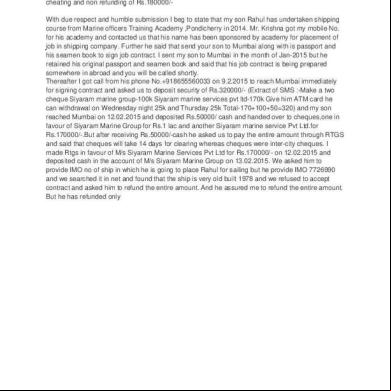Characteristics Of Soft Computing 14383a
This document was ed by and they confirmed that they have the permission to share it. If you are author or own the copyright of this book, please report to us by using this report form. Report l4457
Overview 6h3y3j
& View Characteristics Of Soft Computing as PDF for free.
More details h6z72
- Words: 280
- Pages: 11
Characteristics of Soft Computing
Characteristics • Human expertise • Biologically inspired computing models • New optimization techniques • Numerical computation • New application domains • Model-free learning
• Intensive computation • Fault tolerance • Goal driven characteristics • Real world application
Human expertise • Softcomputing utilized human expertise in the form of fuzzy if then rules as well as in conventional knowledge representations to solve practical problems
Biologically inspired computing models • Biological neural networks-artificial neural networks • Perception, pattern recognition, non linear regression and classification problems
New optimization techniques • • • •
Genetic algorithm Simulated annealing Random search Down hill simplex method
Numerical Computation • Softcomputing mainly rely on numerical computation • Using symbolic techniques in soft computing is an active research area within this field
Model free learning • Neural networks and adaptive fuzzy system have ability to construct models using only target system sample data
Intensive computation • Neuro-fuzzy and soft computing rely heavily on high speed computation to find rules or regularity in data sets • It is a common feature of all areas of computational intelligence
Fault tolerance • Fuzzy and Neural networks exhibit this property • Deletion of a neuron in a neural network or a rule in fuzzy inference system does not destroy the system • Performance quality deteriorates
Goal driven characteristics • Domain specific knowledge helps to reduce the amount of computation and search time • Path leading from current state to the solution does not really matter
Real world applications • Built in uncertainities • Conventional approaches becomes little difficult to be solved • Softcomputing techniques gives satisfactory solutions to real world problems in various disciplines all over the world
Characteristics • Human expertise • Biologically inspired computing models • New optimization techniques • Numerical computation • New application domains • Model-free learning
• Intensive computation • Fault tolerance • Goal driven characteristics • Real world application
Human expertise • Softcomputing utilized human expertise in the form of fuzzy if then rules as well as in conventional knowledge representations to solve practical problems
Biologically inspired computing models • Biological neural networks-artificial neural networks • Perception, pattern recognition, non linear regression and classification problems
New optimization techniques • • • •
Genetic algorithm Simulated annealing Random search Down hill simplex method
Numerical Computation • Softcomputing mainly rely on numerical computation • Using symbolic techniques in soft computing is an active research area within this field
Model free learning • Neural networks and adaptive fuzzy system have ability to construct models using only target system sample data
Intensive computation • Neuro-fuzzy and soft computing rely heavily on high speed computation to find rules or regularity in data sets • It is a common feature of all areas of computational intelligence
Fault tolerance • Fuzzy and Neural networks exhibit this property • Deletion of a neuron in a neural network or a rule in fuzzy inference system does not destroy the system • Performance quality deteriorates
Goal driven characteristics • Domain specific knowledge helps to reduce the amount of computation and search time • Path leading from current state to the solution does not really matter
Real world applications • Built in uncertainities • Conventional approaches becomes little difficult to be solved • Softcomputing techniques gives satisfactory solutions to real world problems in various disciplines all over the world










